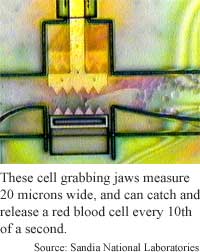
Tiny
jaws snatch cells
By
Kimberly Patch,
Technology Research NewsThe human circulatory system is full of what are essentially micro machines -- red blood cells that carry oxygen, platelets that stop wounds from leaking, and white blood cells that engulf harmful bacteria.
One branch of microelectromechanical systems (MEMS) research is aimed at figuring out ways to make and control inorganic machines as small as some of nature's biological constructions. In that vein, researchers from Sandia National Laboratories have produced a set of tiny, silicon micro jaws that can open and close rapidly to trap and release red blood cells one at a time.
The device demonstrates that it will eventually be possible to puncture and inject substances into single cells, said Jay Jakubczak, a senior manager of MEMS science and technology at Sandia National Laboratories. This will be useful for studying interactions within and among cells, said Jakubczak.
The tiny teeth could eventually be used to isolate, manipulate and gain information about microscopic particles in many different environments, said Jakubczak. "Overall, this technology... may have impact in the areas of drug discovery, drug delivery, prosthetics, vision, and hearing," said Jakubczak.
The jaws are about 20 microns wide, contain five upper and five lower teeth, and are powered by an engine that measures 100 by 100 microns. A red blood cell is about five microns in diameter, and a human hair about 75 microns in diameter.
The lower jaw of the microdevice resides in a tiny channel flowing with red blood cells immersed in liquid. The upper teeth slide back and forth across the channel, trapping and releasing a red blood cell about every tenth of a second.
The researchers made the device and channel using the same silicon wafers and lithographic processes used to make computer chips. This means many of the tiny machines can be stamped out on a single silicon wafer, making their manufacture relatively inexpensive. To make chips, manufacturers deposit layers of metal, semiconductor and insulator in certain patterns on the silicon wafers, then etch material away to fashion features.
More complicated microfluidics machines can also be constructed this way, according to Jakubczak. "The big impact of a technology such as this is that many functions needed in a fluidic system can be integrated onto a single silicon chip -- pumps, valves, actuators, electrodes, channels, mixers -- [and] these microfluidics silicon chips can be manufactured in silicon wafer fabrication facilities like the ones used today to make integrated circuits."
One key to the prototype's success is that the microchannel is made from silicon nitride, which is both transparent and an electrical insulator. This makes it easier to track what is happening in the channel by taking advantage of the transparency to use optics, and the insulation properties to use electrical and magnetic fields to analyze and manipulate the contents of the channel without shorting out the chip.
The next step is to get the microteeth to actually puncture the cells to allow them to absorb substances, said Jakubczak. "Though not demonstrated to date, these microteeth would roughen the cellular membrane of individual cells, making it possible for molecules of interest to be inserted through the cell. These molecules would be present in the channel with the cells or might be inserted through hollow capillaries in the microteeth themselves," he said.
If Sandia is able to use the technique to make a device that successfully injects substances into cells, it would pave the way for doing so on a much larger scale and at much lower cost than is possible today, said Jakubczak. Current techniques for introducing chemicals into cells include using electricity to break down cell walls, which kills many cells, and manually puncturing cells with very fine pipettes, which is a labor-intensive process.
The tiny teeth could also be used to manipulate individual nanoparticles within cells, said Jakubczak. "You might envision an array of micron-sized electrical probes that when activated can cause nanoparticles to separate by their particular electronic charge," he said.
The device could find applications in the research community within the next three to five years and in commercial products within five to ten years, according to Jakubczak.
Jakubczak's research colleagues were Murat Okandan, Paul Galambos and Sita Mani of Sandia National Labs. The research was funded by Sandia.
Timeline: 3-10 years
Funding: Government
TRN Categories: Microfluidics and BioMEMS
Story Type: News
Related Elements: None
Advertisements:
October 3, 2001
Page One
Neurons battle to a draw
Quantum crypto gear shrinks
Toy shows bare bones of walking
Tiny jaws snatch cells
Plastic mix helps shrink circuits

News:
Research News Roundup
Research Watch blog
Features:
View from the High Ground Q&A
How It Works
RSS Feeds:
News
Ad links:
Buy an ad link
| Advertisements:
|
 |
Ad links: Clear History
Buy an ad link
|
TRN
Newswire and Headline Feeds for Web sites
|
© Copyright Technology Research News, LLC 2000-2006. All rights reserved.